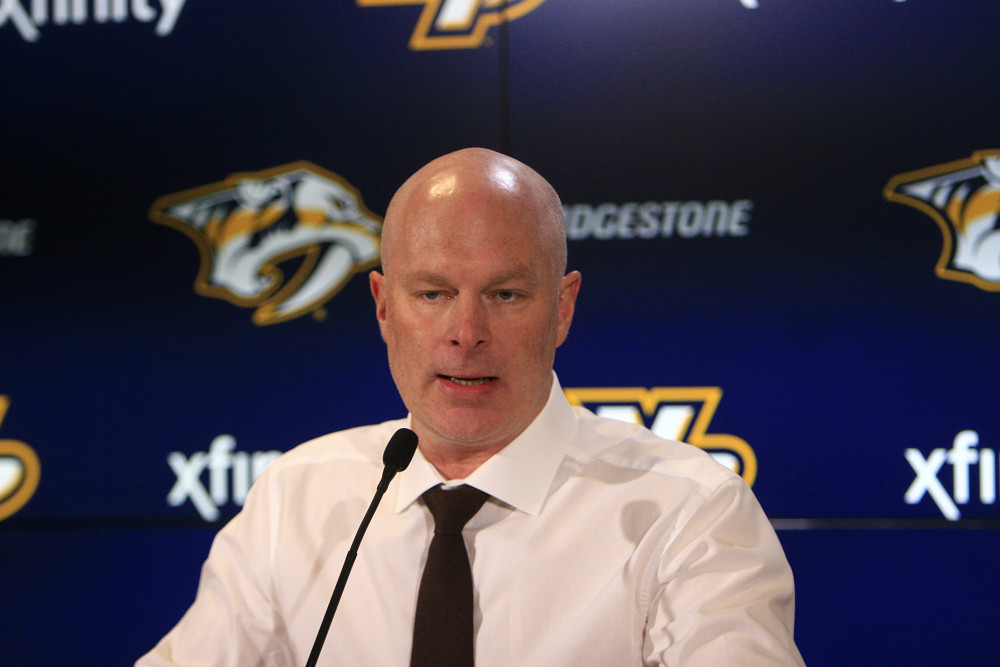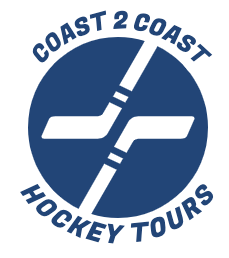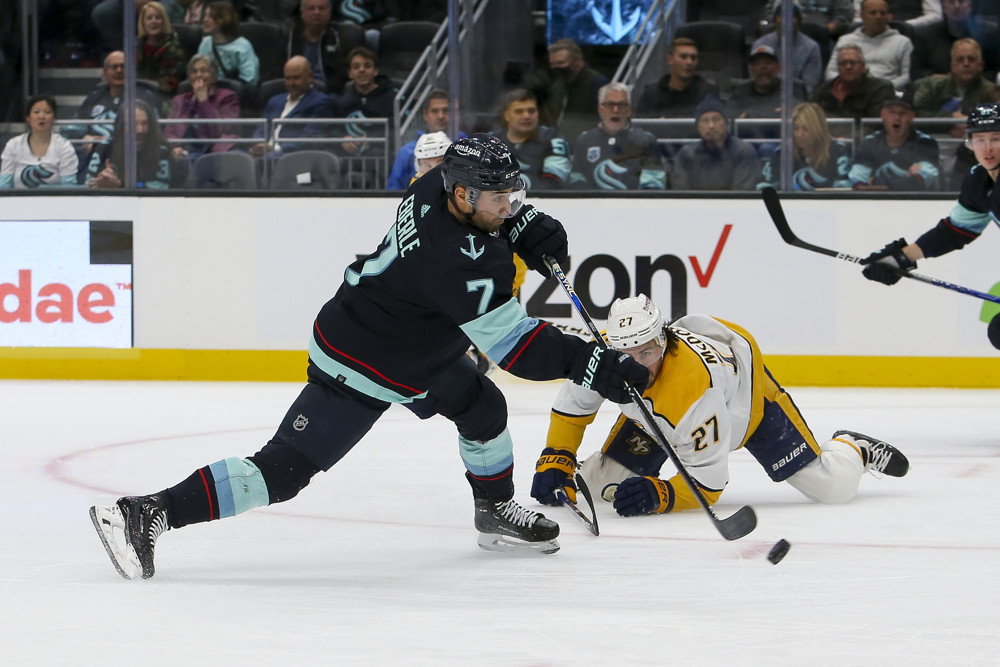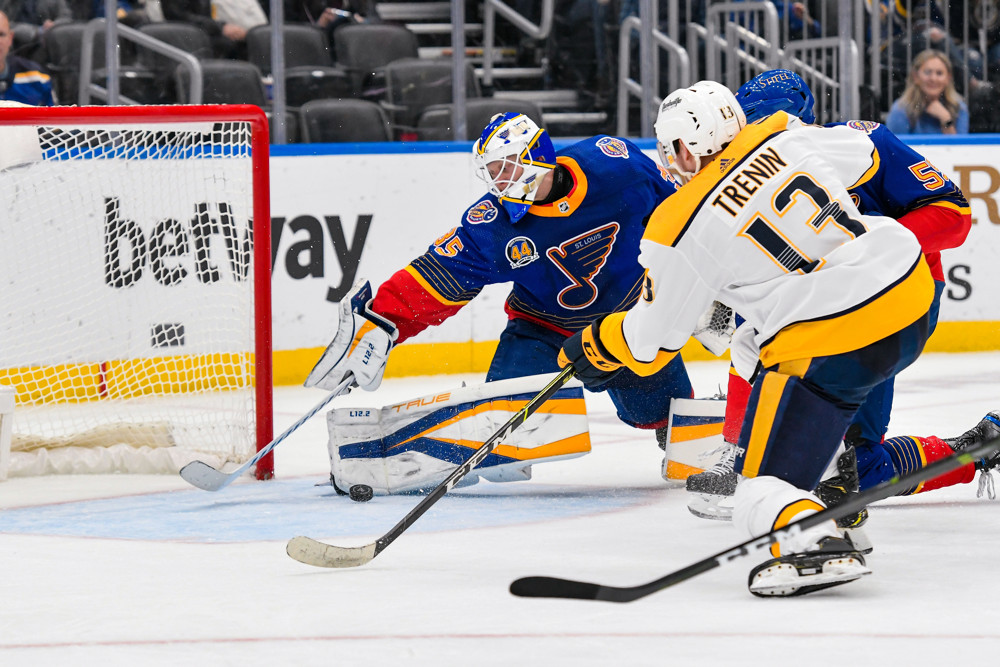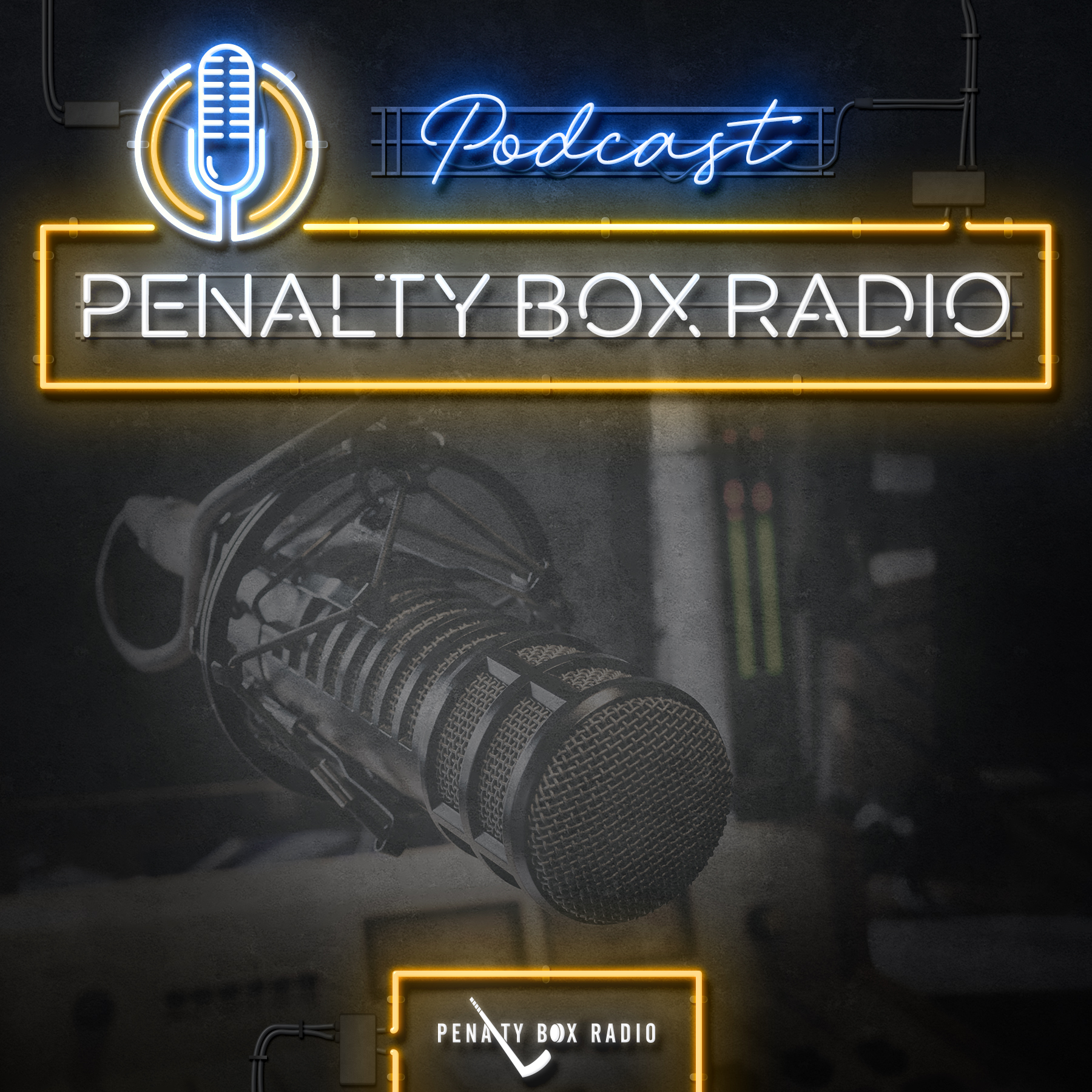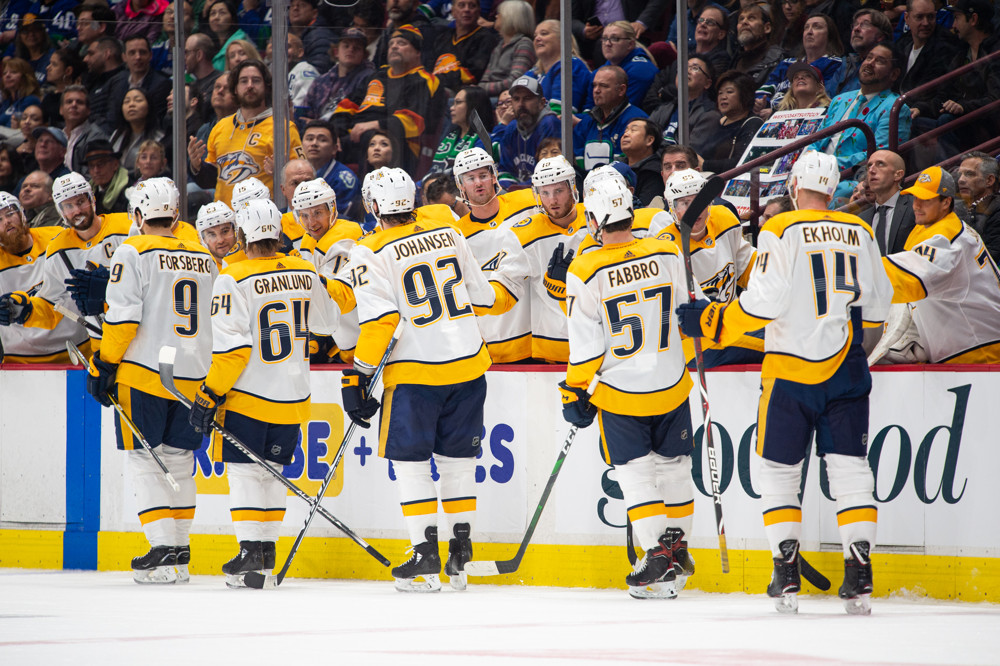
Ding dong the witch is dead. Peter Laviolette is no longer the head coach of the Nashville Predators, and let’s just say there’s been mixed reactions. Many from the outside have lambasted this move and claimed the issue was solely goaltending. Meanwhile, certain fans have been clamoring for this move to be made since the playoff loss to Dallas.
Many saw that defeat as a stun or shock, but the Nashville-based analytics community knew it was a distinct possibility. The issues that faced the 2018-19 Predators are still around to this day.
I, personally, blamed the system and its architect. How could a top six of Johansen, Forsberg, Arvidsson, Granlund, Turris, and Smith not produce one player over 64 points? Especially since Johansen and Granlund have scored more in previous seasons, albeit on different teams.
So, now that the hammer has dropped and a head has rolled, what exactly has gone for the Predators and what will get them on track.
Note: All stats are solely at 5v5
Good, then Bad

I’ve been called a pessimist before and I’ll own that title, but it’s not all doom and gloom in Nashville. The very simple stats have the Predators as a good team dealing with some below-average goaltending.
As I write this on January the seventh, the Predators have the sixth-best shot attempt and shot on net differential, second-best goal differential, ninth-best expected goal differential, and 11th best high danger chance differential.
All this stems from their impeccable defense. I know that many people will try to argue against this point, but the stats prove it. The Predators have the third least expected goals against while also allowing the seventh-fewest high danger chances against. Despite these top ten numbers, the Predators’ goals against numbers are in the teens.
The defense is pulling their weight while the offense has been inconsistent. The Predators have scored the third most goals so far, but I’d be lying if I said it was sustainable.

The coaching staff clearly stressed quantity over quality, and it shows. The Predators produced the eighth-most shot attempts and 11th most shots, but fail to crack the top 20 in expected goals, scoring chances created, and high danger chances created. They’re mostly saved by their collective 9.6 shooting percentage, good for second in the league, which is currently being led by nine players shooting over league average.
Scoring has come in bunches and when it rains, it pours. But the issue with an unsustainable offense is what’s in the name, it’s unsustainable. We’ll get to that later though, now let’s dive a little deeper into their strengths and weaknesses.
Move the Puck, You Cowards
My belief is that the best way to play defense is to play as little of it as possible. I believe this to such an extent that even the high school team I coach uses this as our mantra. But it’s always easier said than done, so how do the Predators play more in the offensive zone. The key is to move the puck with certainty, and to do it early and often.
Through the 31 games that I’ve manually tracked, the Predators have had some good numbers. A lot of it comes from only a few players, but regardless the numbers are positive. They’ve attempted to exit the zone 2,750 times, with 2,315 of those actually leaving the zone.

That means 435 of those attempts failed, but what does failing mean? Essentially, it means that a player tried to move the puck up the ice but it didn’t exit the zone due to being picked off or because of icing. Mattias Ekholm is the king in this regard with 59 failed exits and 2.45 fails for every 20 minutes played.
The good news is that the Predators still exited 2,315 times, but are all exits the same? The answer is no. The difference between a possession exit versus non-possession exit is the difference between moving the puck comfortably up the ice or praying your team can win a 50/50 puck battle.
Efficiency is the name of the game and he Predators exit the zone with about 84.1% of the time, but of the 2,315 completed exits, only 1,263 came with possession. 537 of those came from players carrying the puck and 726 came from completed passes.
So, of the total attempts made (ones that made it out or didn’t), the Predators exited the zone with possession 45.92% of the time. But of completed exits, the Predators exit percentages jump up to 54.56%. So things are good, but they can be better.
A lot of the above numbers come from just a few players though. Everyone and their mother could have guessed that Roman Josi leads the team in carry-outs, with 84 and 3.44 per 20 minutes played. Meanwhile, Dante Fabbro has risen to fill the shoes left by breakout maestro P.K. Subban. Fabbro leads the team with 109 passes out, though he’s closely followed by Ryan Ellis with 99.
Fabbro started the season as blackhole of zone exits but has really blossomed as the season has gone on. It’s really a shame he’s hurt because he was starting to put things together. He’ll be an interesting player to watch as wins become more necessary, especially with how Ekholm has failed to step up in transition.
Enter without Caution
As important as exiting the defensive zone is, entering the offensive zome might even be more important. Through the great work of @garik16 on Twitter and hockeygraphs.com, we’ve come to know that an entry with possession is twice as likely to lead to an unblocked shot attempt. So now that we know how valuable entries are, try to avert your eyes from the horror below.
The Predators attempted to enter the offensive zone 2,250 times with 2,052 of those being successful. Meanwhile, they failed to enter 198 times, about 8.8% of the time. That’s objectively pretty bad as about one in ten attempts doesn’t enter the zone or ends up in an offside. Weirdly enough, Ekholm also leads in this regard with 25 failed attempts, over 12% of total amount.
As our tour of misery continues among the Predators’ entry numbers, let’s look at their successes. Roman Josi once again leads the way with 71 carry-ins, although that’s second on the team in terms of per 20 minutes played. Filip Forsberg leads in that regard with 4.23 but Matt Duchene and Rocco Grimaldi are close on his heels.
Josi once again leads in pass ins with 52, and it’s not even close. Ekholm finishes second with 22 fewer passes and there are actually 13 players with over 10 passes into the offensive zone. It’s good to see that the Predators are “spreading the wealth”, so to speak, but 10 doesn’t feel like enough, in my opinion.
The Predators entered the zone successfully 2052 times but only did so with possession 896 times. That’s a completion rate of 43.66%, so the Predators are dumping the puck in over half of the time. The top six doesn’t have much of an issue, but Mattias Ekholm and the bottom six forwards each have over 60 dump ins so far.
The Predators are good at exiting but can’t enter the zone with possession to save their life. The coaching will need to take a good hard look at how the Predators enter the zone. A personnel change could help, but players like Calle Jarnkrok and Mikael Granlund can and should do better. It’d be nice to see Josi not have to do too much heavy lifting, but use the horses while you have them, I guess.
Quality Vs Quantity
We’ve already discussed at great lengths about how the Predators have dominated quantity with tons of low percentage shots, but their quality has suffered. By taking every shot available, the Predators have in turn passed up the “right” shot. And while the NHL, and others, track shots from the slot, no one publically tracks passes to the slot.
So that’s where I come in. I’ve tracked passes to the slot in the offensive and defensive zone, and the results are terribly surprising. The passes to the slot stat eerily resemble the offensive numbers we looked at earlier. They’ve completed 135 passes to the slot in 31 games, good for 4.35 per game. The seems like a pretty decent mark, but the issue is that they’ve attempted 352. So they’re only completing 38.35% of those passes. Ryan Johansen, Duchene, and Forsberg lead the team with 17 completed passes each, Josi is hot on their tracks with 16, but the next closest is Kyle Turris with 12. It continues to drop from there. Unless it’s one of those four, the puck probably isn’t being passed to the slot, which is counterproductive.
Offense continues to be a problem, but does the defense hold up? The short answer is no, and the long answer is no, but the even longer answer is that the Predators have surrendered 179 completed slot passes on 331 attempts. This stat is hard to track, as usually, more than one player is to blame, but I’ve done my best to individualize it. Fabbro has a stranglehold on this crown, as he’s given up 33 passes to the slot, 10 more than the next most (Josi). The good news is that some players are shutting the house down.
Ryan Ellis and Dan Hamhuis lead the way in clearing the slot. They’ve stopped 24 and 22 passes to the slot, respectively. Ellis has had a great year even though his partner is getting the majority of credit. I won’t bad mouth Josi, because he’s been lights out, but Ellis deserves much more praise than he’s getting. Hamhuis has his own issues, but his defensive play has been steady. Surprisingly steady even, especially when you consider who he plays with.
I’ve Been Waiting
The Nashville Predators could still make some serious noise this season. I’m as doom and gloom as they come but I could see a new offensive system really helping to turn this team around.
John Hynes’ strategy in New Jersey was focused on taking the “right” shot instead of taking as many shots as possible. Another possible strategy change could be moving away from depending on rush attempts, and moving to a heavier possession-based style. That would benefit some of the current slumping players, namely Johansen, Turris, and Granlund.
I won’t pretend to know what changes Hynes will make, but I do think this boat could be turned around rather quickly. It just depends on how different the changes are, and if the goaltending ever comes back to normal.
Goaltending is the end all, be all. You could have a team made from the best players throughout hockey history on the ice, but if Martin Jones is their backstop, they’ll never make it close to the Cup. And while Pekka Rinne and Juuse Saros have been (marginally) better than Jones, they haven’t been their usual selves.
Saros has given up over 6 goals above average and 12 above expectation, meanwhile Rinne goes AFK whenever the Predators take a penalty. Both currently have sub .895 save percentages in all situations and there’s reason to worry. Rinne is at that age where goalies hit a wall and there’s a chance he might never come back up to his usual standards. Plus, he’s had some surgeries and those are usually the kiss of death for athletic goaltenders.
There’s hope Saros will bounce back to his usual self, but goalies, especially goalies this young, are still voodoo in my opinion. I like that the Predators are still feeding him starts, but the Predators need Saros to return to form quickly. If the Predators can receive even average goaltending, I expect them to return to the playoffs. But that’s a big ask, and not one a new coach can fix.
So can John Hynes save the Predators? The answer is no, but that doesn’t mean the Predators are goners. It just means that while there is plenty of room for improvement, especially on offense, the biggest issue remains something that doesn’t abide by normal rules. I hope Hynes uses his time and I’m very excited to see what a new system does for the Predators.


